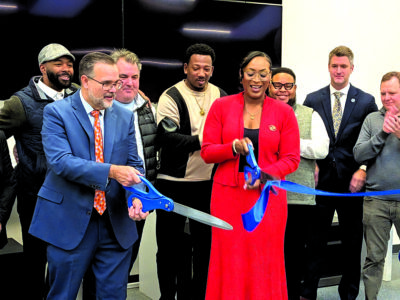Choffin students laud black hairstyle trends
Cosmetology event reflects on history of diversity
YOUNGSTOWN — The Saturday before Easter, the smell of a hot-comb that has been gently resting on a lit gas stove hitting your hair is a cultural experience for black people.
That experience was described by first-year Choffin Career and Technical Center cosmetology instructor Taneka Allison.
Allison shared with students that the hot-comb was believed to have been created by a black man named Elroy J. Duncan. It was one of many lessons taught as part of Choffin’s latest Black History Month celebration.
Allison, along with her junior and senior students, hosted a presentation and fashion show centered on showing and telling the history of black hair.
“Black people were innovative, a lot of hair trends, products and tools were created by black people. So it’s important that we stress that history for our students,” Allison said.
The event started with Allison and her senior students as they discussed hair types, textures and the origins of the diverse hairstyles such as braids, along with weaves and extensions.
Walking the class through history, Allison took things back to the Trans-Atlantic Slave trade when African Americans would braid maps into cornrows to help themselves escape enslavement.
During the 1960s and 70s, a natural hair movement came about. Allison discussed how the afro, although rooted in the 1700s, was worn in that era as a symbol of black pride — it was notably worn by actress Pam Grier and black panther party member Angela Davis.
The movement known as Black is Beautiful, combated the European beauty standards of straight hair to encourage the idea that blackness is beautiful.
Prior to this movement, “creamy crack,” a term referring to chemical relaxers often used by black people to straighten their hair, was popular. Often, black people that used this hair care method became reliant on the product to maintain straightened hair, and the addictiveness to using treatment birthed the nickname, creamy crack.
“These products allowed black people to link into the European beauty standard,” Allison said.
Opening the floor to her students, several of them discussed the many nuances of black hair.
One senior student, E’Leccia Fornore, talked about wigs and hair extensions, which Fornore said was first documented around 3400 BC in ancient Egypt. She noted that the wigs were glued to natural hair using wax from trees, plants and bees.
Senior Aries Woods further elaborated on the history of braids. Woods discussed how African tribes long ago used the braided hairstyle to identify themselves by tribe. Woods shared that the style also could give insight into a person’s wealth, power, religon and other signifiers.
“What I tell my students all the time is, the good thing about taking cosmetology is that you learn where everything came from, but it’s so important to know where things started, so you know where you’re going. A lot of good things repeat themselves,” Allison said.



